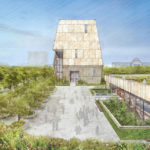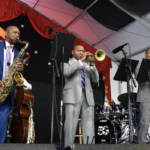By CHAD GILLIS
The News-Press
MIAMI (AP) _ Cobalt blues and salmon pinks flash by like a meteor shower during a new moon as a group of middle school students parade through the main hall of the Miccosukee Embassy in Miami.
Dressed in colorful patchwork shirts and dresses, the 18 students are here to say the pledge of allegiance. The pledge isn’t to the American flag. It’s to the Miccosukee flag and a people who have survived 500 years of oppression.
“All helping one another,” as one line says when translated into English.
These children are tribal members, part owners of the vast gambling and resort corporation. They’re also the newest generation of the Miccosukee Tribe of Indians of Florida, who number about 600 and live mostly on reservation lands about 100 miles southeast of Fort Myers.
Once finished, the children scamper off to the banks of the Miami River, the aquatic artery that once connected the Miccosukee to the entire Everglades. There they eat fry bread and sip sodas, talk about the Internet, cellphones and school.
Miccosukee chairman Colley Billie takes the stage, his baritone voice bouncing off the marble floor.
“It was our refuge, it was a place that fed us,” Billie says. “And the reason we wound up in the Everglades is because the United States government was unleashed on us to exterminate us. We went into the Florida Everglades as a place of refuge. We will always consider it our home.”
The Everglades has changed in the last century, and Indians have changed with it. From a mostly ancient life of hunting, gathering and spiritual ceremonies, modern Indians have mastered the American economic model, building an international casino and resort empire.
The challenge is maintaining traditions and protecting the Everglades from further ecological damage while integrating technology and moving even more into the modern world.
Like any group, they vary in personal beliefs, spiritual convictions and financial status, but all factions The News-Press interviewed over the past eight months have similar goals: Grow their power and influence across the region _ economically, environmentally and spiritually.
The tribes are taking control through a gambling and resort empire that brings in billions of dollars of revenue each year (the Seminole Tribe reported $2 billion in revenue in 2012).
Both the Seminole Tribe of Florida and the Miccosukee Tribe of Indians of Florida own resorts throughout much of Florida, the United States and in Europe and Asia.
These businesses started as high-stakes bingo in the 1970s, when the federal government gave exclusive gambling rights to Indian tribes. Although casinos were already established in the Miami area, the tribes have since established gambling in Tampa, Immokalee, Hollywood, Dania, Clewiston and Brighton. The businesses bring in billions of dollars of revenue each year, and members reportedly get $100,000 or more in annual dividends for being part of the tribe.
Business ventures include:
. Casinos in Florida, Mississippi, Nevada, Ohio, Dominican Republic, China and Singapore
. Resorts in Florida, California, Mexico, Thailand and Malaysia
. Extensive cattle and farming operations.
Even sponsorships of a NASCAR team from 2002 through 2009 were part of their economic DNA.
The Seminole Tribe is looking to expand its empire. After canceling plans to build a $465 million casino in Atlantic City, the Seminole Tribe is reportedly interested in buying the Revel Casino Hotel, which would also give them an Internet gambling license _ another entry into the gambling world.
And there is talk of expanding its Immokalee casino, including a possible Hard Rock hotel nearby.
The money means the tribes can hire attorneys and water management experts to fight or support state or federal water policy changes or any Everglades restoration projects.
“It’s not that we want to sue them,” says Miccosukee Tribe member Michael Frank about water management agencies and the National Park Service. “It’s just that they break their own laws.”
The traditional Indians _ relatives of tribe Indians who shun reservation life and American politics _ are fighting a moral and spiritual battle, citing human rights violations, genocide and centuries-old treaties.
The future of the traditional Indians seems grim. As many have said, they are going extinct. They don’t keep count of their people _ it’s against their cultural ways _ but the estimated population is around 100.
“In the old days we were taught to keep out of the white man’s way, but there are so many that we have to stand up and fight for ourselves,” traditional Indian LeRoy M. Osceola explains.
They also want access to the national park lands _ millions of acres Indians used for centuries. Everglades National Park lands were used to gather medicine, building materials and food. Those practices are now illegal because the lands are within a national park. Losing those lands makes living a traditional Indian life even more difficult, some say.
Bobby C. Billie and other Indians say these laws are used to force traditional Indians to live a more modern life. Regardless of their desires to hunt, fish and use medicine in their ancient ways, the outside world has made that life virtually impossible through laws and regulations.
“We have to talk to the government or Big Cypress preserve area to try to get into it to cut the material or go hunt or go fishing like we did when we was younger,” says Bobby C., a traditional Indian. “They say `you can’t do that. You have to buy a permit or buy a hunting license.’ But we can’t (buy a license). It’s not our way.”
Most Indian children are part of the Seminole or Miccosukee reservations, although a handful are being raised in traditional villages by non-reservation clans. Most attend reservation school through eighth grade and then attend a public high school.
The modern wealth offers options as children start drawing reservation dividends shortly after birth. College, cars, houses, travel, fine meals, swamp buggies and airboats are financially feasible for reservation teens. Cellphones and iPads are common, too.
Some are preparing for college, others to be future tribal leaders, business owners, clothes designers, cowboys and environmental engineers.
Sandra-Laurie Osceola is focused on maintaining her traditional roots and clan ties. Her son, Standing Bear Osceola, 20 months, is one of a dozen or fewer Florida Indians still being raised in a traditional Indian village among non-reservation Indians.
Her future, she says, is with her clan _ her close and extended family. Sandra-Laurie’s father, LeRoy M. Osceola, is one of the most outspoken traditional Indians and is the head of four generations of traditional Indians living on their own land, not within the reservation borders.
“I get asked all the time, why I don’t enroll and get the free money,” she says. “For me, it’s out of respect for my father, what he has taught us. I can’t imagine betraying him like that.”










